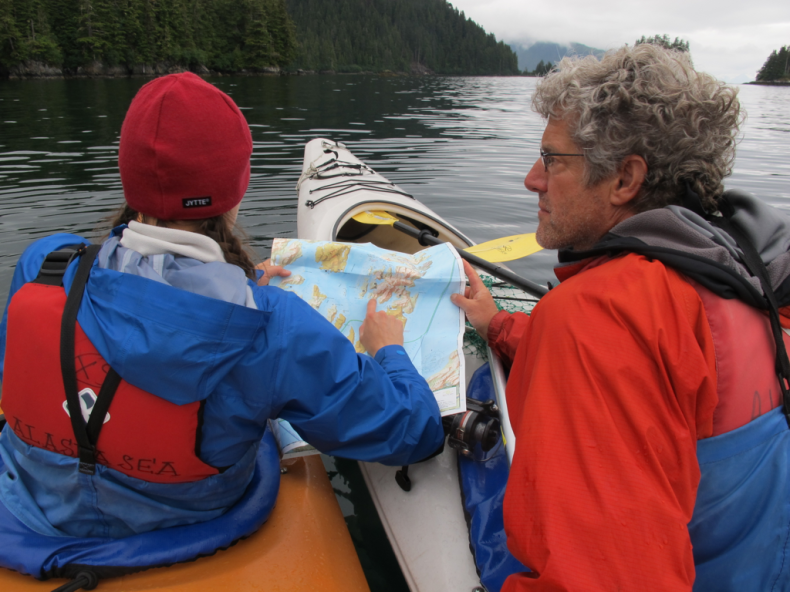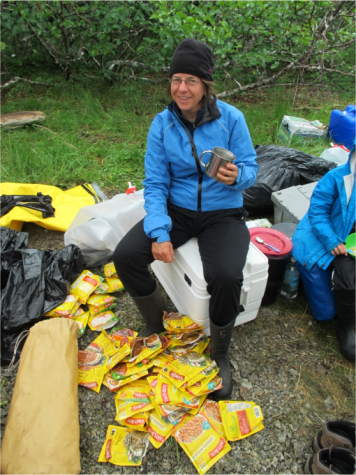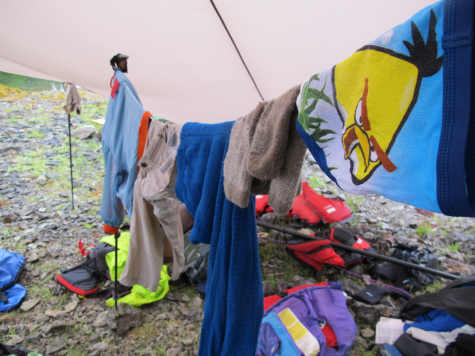 Camped with seven adults and five children on the south-central coast of Alaska, I was doing a little writing experiment. I had been following possible Paleolithic routes, taking off with adventurers across glaciers and mountains to get a sense of living and traveling in the same landscapes people faced tens of thousands of years ago. One thing was missing: families.
Camped with seven adults and five children on the south-central coast of Alaska, I was doing a little writing experiment. I had been following possible Paleolithic routes, taking off with adventurers across glaciers and mountains to get a sense of living and traveling in the same landscapes people faced tens of thousands of years ago. One thing was missing: families.
Following a hypothesized coastal migration route from 16,000 years ago, we headed out in a gaggle of sea kayaks. We’d been dropped off three hours by boat out of Whittier, Alaska, for a 9-day trip. By day 5, we were running low on food, turning to foraging, digging up clams, setting a shrimp pot, and catching whatever we could by hook and line.
As if going through a house after a nightly rampage of children and pajamas, one evening we put away toothbrushes and picked up stray, damp articles of clothing, hanging them on guy-wires from the kitchen tarp. And not like living in a house at all, we collected all food that wasn’t in hard-plastic bear boxes and packed it into bags to hang as high and as intricately as we could. We had a pulley system rigged up over the water, about a hundred pounds of food suspended from a rope thrown over a sturdy spruce hanging 30 feet above the incoming and outgoing tide. It was as far as we could get food from bears.
Gender was an issue from day one. Our tasks divided by male and female. It was never discussed. It just happened. That evening, I sat with Becky Ela, a mother of two from a farm family in Western Colorado. Becky and I sat at the edge of the kitchen tarp. I was on the dry ground and she was on a cooler whittling a stick into a rug of wood shavings. Rain fell in dusk light darkening into an early-July midnight. Tent lights went out, other parents putting kids down for the night.
 As Becky curled back wood with her knife blade, she said, “I love having a small contained existence in the wild. I lie in the tent at night with my family all around and think, I love this.”
As Becky curled back wood with her knife blade, she said, “I love having a small contained existence in the wild. I lie in the tent at night with my family all around and think, I love this.”
She smiled at me and said, “No offense, but probably more than you do.”
I asked what she thought about the gender roles we’d developed. Becky took a breath, slivered off another curl, and told me it seemed clear that women were doing the meal planning and most of the cooking, while the men were building fires, catching fish, etc. “We’re all working and its equal to keeping things going, but different.”
When pressed a little more, she told me that she and my wife — the two mothers — knew where all the kids were at any moment, and knew what they were doing, who was cold, who had spilled hot chocolate all over their pants, who couldn’t find their socks, regardless of whose kids they were. “I think that’s a pretty gender identified awareness,” she said.
Her face hid nothing, and as she whittled, she appeared as content as a mother could be, sitting with a friend out of the rain on a wilderness island. The roles we’d taken on didn’t seem to trouble her any more than weather.
“I think if we stayed here longer, our gender roles would evolve,” Becky said. “We’ve got three strong, competent women who are probably just as happy fishing and paddling and lighting fires as, say, boiling ‘Tasty Bites.’ Given the duration of our stay, I believe that we’ve just settled into roles which we know and others have come to expect — perhaps not what we would choose but what we fall into.”
“You think we were the same in the Ice Age?” I asked.
Another flick of wood.
“Yes.”
Nicole Waguespack, an archaeologist at University of Arizona, has taken on the question of gender roles in the Paleolithic. “It has long been recognized that women in foraging societies often produce more perishable forms of technology,” Waguespack writes. “By preferentially manufacturing goods out of “soft” organic raw materials (i.e., plant products, leather, and sinew) as opposed to harder materials (i.e., stone, bone, antler, and wood), technological items manufactured by women are unlikely to be preserved in most contexts.”
The disappearing presence of women in the archaeological record she calls, “the incredible shrinking prehistoric woman.” This she takes from the 1981 movie The Incredible Shrinking Woman in which actress and comedienne Lily Tomlin slowly diminishes in size over the course of the film. Waguespack writes that “[Paleoindian] women, and their counterparts in the multitude of other prehorticultural societies of the past, are often interpreted much like thousands of little Lily Tomlins. Their archaeological presence slowly diminishes as artifacts and evidence of their labor literally pass under researchers’ trowels, slipping unnoticed through our sediment screens and behavioral models.”
Waguespack says it is more nuanced than women disappearing into the record while stone tools and ivory lances of men live on. She points out that the more a hunting and gathering group is focused on meat, the more female labor is directed not toward food-gathering, but toward “house building, leather working, and burden carrying.” Women’s work becomes the thing that lies between hunting and gathering, the sewing work and nursing that keeps a camp from coming apart.
Of course, this relies on a big assumption that modern hunter gatherers were anything like Paleolithic foragers who were going for mastodons and seaweed, leaving the remains of their meals down the west coast of the Americas. Things may have been different back then.
Going with scientific givens, Waguespack writes, “equating women solely with plant gathering is reducing their role in prehistoric societies to activities for which they may have spent little time and effort. The ‘shrinking’ phenomenon may not be entirely the effect of preservational bias but the inherent bias of archaeologists limiting female labor to the plant realm.”
When I told Becky of Waguespack’s research into women disappearing through the archaeological record, she laughed. “We don’t leave artifacts? Come on, we leave the only real artifact there is.”

This was a fascinating article on a topic I’d never given much thought to before. Too bad your experiment couldn’t last long enough to see how roles settled over time, but I imagine that Becky’s observation is close to correct, providing there isn’t a societal expectation of gender roles to prevent some from either sex from stepping outside the norms established early on. I’m a writer too, and questions like this provide good fodder. Thanks for the interesting read!
Gathering or growing plants and then preserving them for later use takes a lot of work and knowledge that has also disappeared from the record. Knowing what kind of wood to burn to smoke meat, how to roast pine nuts or soak the tannic acid from acorns is part of the huge library of skills women possessed to keep their families alive. Men just went out and hunted animals (risking their lives, of course). They sat for hours honing their spear points while laughing about their women. Meanwhile, the women had to clean the animals, tan the hides, sew them into clothes and tents. Then there’s the basketry and weaving. When I think of what women had to do to survive in ancient times, I feel myself shrinking. Those women were heroes.